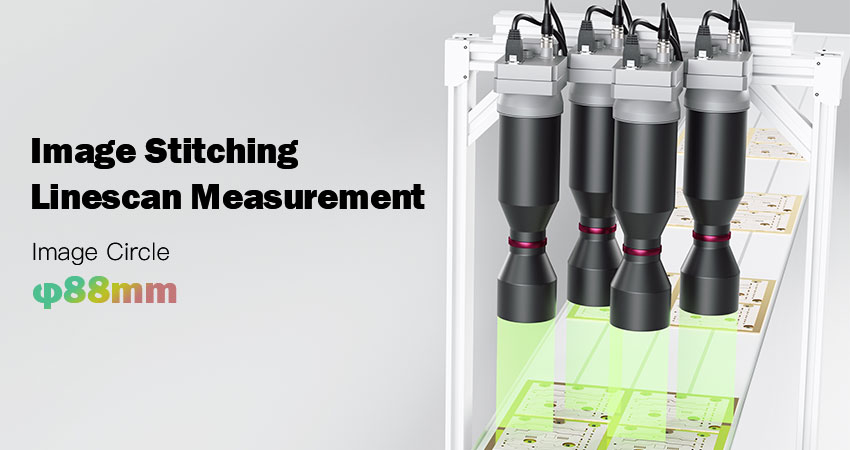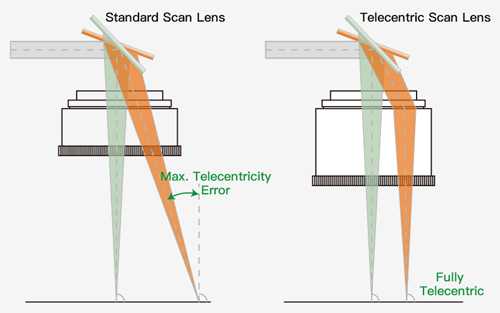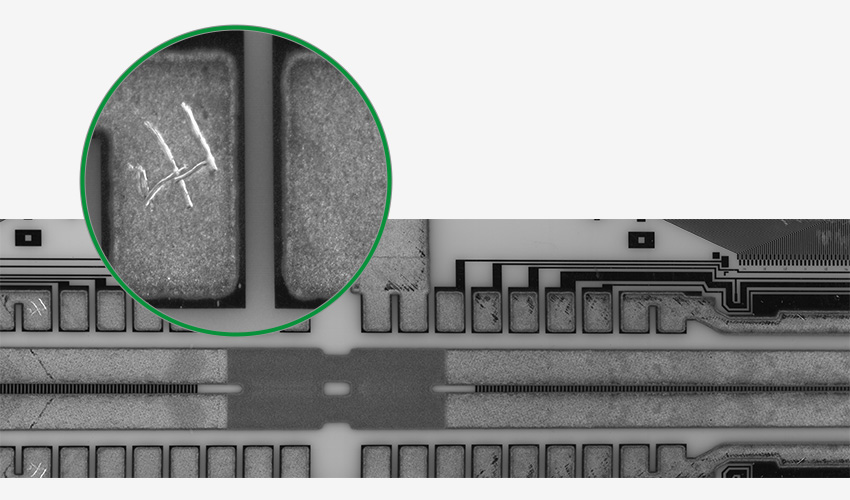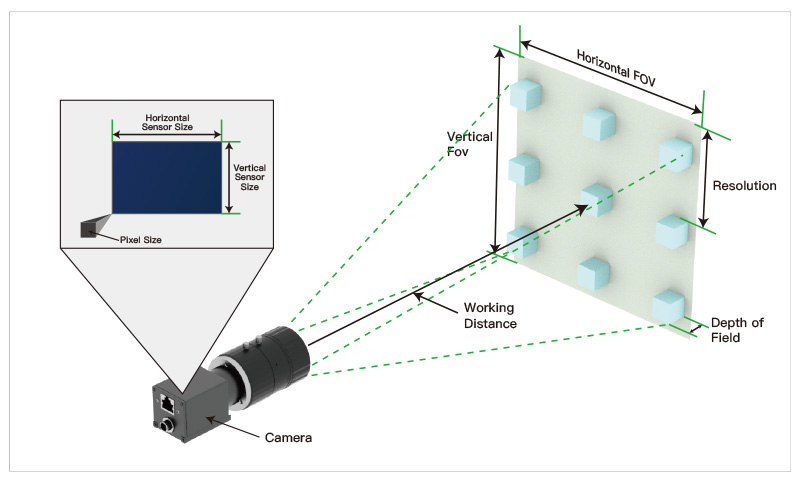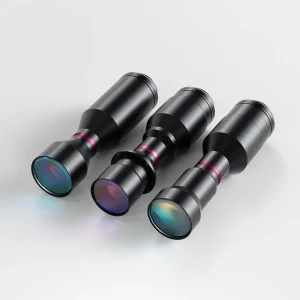Nowadays, we can see a sharp rise in the use of telecentric scan lenses in high-tech imaging systems, especially in the industrial, medical, and scientific fields.
Their capacity to provide high-quality pictures with minimum distortion, even when photographing objects with complicated geometries, is only one of the many benefits these lenses offer over conventional imaging lenses.
What Are Telecentric Scan Lenses?
Regardless of the angle, the primary rays formed by a telecentric scan lens will always be perpendicular to the optical axis. If the light entering the lens is perpendicular to the picture plane, then the resulting image will have low to no distortion.
To better capture high-resolution pictures of complicated geometries like those seen on PCBs, medical devices, and precision-engineered parts, telecentric scan lenses feature a larger entry pupil and a smaller exit pupil than standard lenses.
Why Are Telecentric Scan Lenses Important in Modern Imaging Systems?
There are many reasons why telecentric scan lenses have gained prominence in modern imaging systems.
High-Quality Images
To begin with, they provide accurate images with little to no distortion, especially when capturing items with intricate shapes and surfaces. It is beneficial in scientific and industrial settings, where exact measurements and pictures are paramount.
Advanced Setup
As you know, telecentric scan lenses are often used with other imaging elements, including cameras, sensors, specialized software, and lighting setups. Since these photos are of such high quality, advanced techniques are used to study and interpret them.
Quality control, flaw identification, metrology, and even basic scientific tasks can all benefit from the usage of such pictures.
Better Performance
Telecentric scan lenses’ ability to decrease chromatic aberration, depth-of-field restrictions, and distortion separates them from traditional lenses.
Thus, these lenses are very useful in machine vision, microscopy, and semiconductor inspection, among other imaging applications.
In short, telecentric scan lenses are a crucial part of advanced imaging systems because of their superior image clarity, low distortion, and other benefits. These lenses are expected to play a larger role in various settings as imaging technology develops further.
What Are the Unique Characteristics of Telecentric Scan Lenses?
Unlike conventional lenses, telecentric scan lenses can provide high-quality pictures without distortion because of their innovative optical design.
As explained above, a key characteristic of telecentric scan lenses is their ability to project light beams perpendicular to the optical axis.
The secret is in the design of telecentric scan lenses. Their unique design guarantees that the light rays entering the lens are perpendicular to the optical axis. It is completely opposite to the curved surfaces used in conventional lenses.
As a result, it eliminates any perspective distortion by having light enter the lens at right angles to the picture plane. You will notice that the picture generated by a telecentric scan lens is undistorted regardless of the orientation of the item being captured since the angle of incidence is fixed.
Scanning lenses are used for laser scanners. Telecentric scan lenses are used to focus a laser beam on various points on a target surface in roughly the same direction. The scanning device, such as a polygon mirror wheel or a deflector, serves as the effective entry stop, eliminating the need for a diaphragm.
It all makes these lenses useful in various image processing applications, including industry-specific fields like microlithography, which rely on scanning technologies.
Telecentric scan lenses can also minimize perspective problems and keep the magnification constant, both of which are very useful. It is especially useful in fields like metrology and machine vision, where precise measurement and analysis of images are essential.
What Are Different Types of Telecentric Scan Lenses?
Applications ranging from machine vision and metrology to laser processing rely heavily on optical systems that have telecentric scan lenses.
Compared to standard lenses, telecentric scan lenses provide uniform magnification, little distortion, and stable picture quality.
Telecentricity, the field of view, and wavelength range are three criteria for categorizing different types of telecentric scan lenses.
By Telecentricity:
Based on telecentricity, we can classify telecentric scan lenses as standard and double telecentric lenses.
Standard Telecentric Lenses
These lenses are telecentric solely on the object side. Thus, the light rays are parallel to the picture plane. It makes them perfect for applications that need accurate measuring and examination of items.
They find widespread usage in machine vision systems for tasks like PCB inspection, electronic component production, and precise measurement.
Double Telecentric Lenses
These lenses keep the light beams perpendicular to the object and picture planes, retaining telecentricity on both sides. This function aids in reducing the impact of parallax errors on measurements. These lenses are often employed in metrology applications like 3D measurement systems and coordinate measuring machines.
By Field of View Size:
The field of view (FOV) is another criterion that may be used to categorize telecentric scan lenses.
Large FOV Telecentric Lenses
These telecentric lenses offer a wide field of view and may take clear pictures of distant things. They find widespread usage in machine vision systems, particularly those involving the examination of surfaces, vehicles, and foods.
Small FOV Telecentric Lenses
Telecentric lenses with a narrow field of view are well-suited for capturing microscopic details. These lenses find widespread usage in metrology systems for tasks like wafer inspection and microelectronics production.
By Wavelength Range:
Telecentric scan lenses may also be categorized according to the wavelength range throughout which they operate.
Visible Telecentric Lenses
The visible region of the electromagnetic spectrum, from 400 nm to 700 nm, is where visible telecentric lenses are employed for use. They find widespread usage in machine vision setups, especially inspection and quality control devices.
UV Telecentric Lenses
These lenses are suitable for use in the electromagnetic spectrum’s ultraviolet (UV) region, spanning 10 nm to 400 nm.
They find widespread usage in different fields, including lithography, semiconductor inspection, etc.
IR Telecentric Lenses
Infrared (IR) telecentric lenses are suitable for use in the electromagnetic spectrum’s 700 nm to 1 mm area.
Since each kind of telecentric scan lens has its own set of advantages, it may be used in a wide range of applications. To get precise, trustworthy, and high-quality imaging, one must first choose the right type of telecentric scan lens in accordance with the needs of the application.
What Are the Benefits of Telecentric Scan Lenses?
Telecentric scan lenses are a great option for various applications with numerous benefits over regular lenses. Some benefits of telecentric scan lenses include the following:
Elimination of Perspective Errors
Telecentric scan lenses prevent perspective distortion by keeping the light’s angle of incidence on the object constant. It helps avoid the distortion of an object’s perspective that might result from light striking it at different angles.
That’s why you should use them whenever you want to perform precise monitoring or inspections.
Constant Magnification
Telecentric scan lenses have a fixed magnification that does not change when the item moves away from the lens.
It guarantees that the item will always seem the same size in the picture. Because of this, telecentric scan lenses are perfect for uses that need precise measurements.
Low Distortion
Telecentric scan lenses are low-distortion lenses. Thus, the resulting picture of the item seems more true to life. It makes them a great choice for machine vision and metrology, where the precision and accuracy of the picture are crucial.
Enhanced Contrast
Telecentric scan lenses boost contrast by eliminating the visual impact of background lighting and shadows.
Because of this, they are perfect for applications where it is crucial to pick up on even the most minute variations in the item being scanned.
Extra Large Resolution
Telecentric scan lenses boast a high resolution to catch minute details and provide crisp, clear pictures. The extreme precision and accuracy they provide make them perfect for applications like semiconductor inspection.
What Are the Common Applications of Telecentric Scan Lenses?
Because of its ability to deliver constant magnification, minimize parallax errors, and guarantee high accuracy and precision in measurements, telecentric scan lenses find widespread use across various sectors that rely on precise imaging.
Machine Vision
There are several uses for telecentric scan lenses. Still, one of the most popular is machine vision, where high-quality image capturing is crucial for inspection, sorting, and measurement.
Telecentric scan lenses find applications in many sectors, including the electrical, food and beverage industries.
These lenses can help you get repeatable, precise readings if you’re picturing anything with complicated geometry.
Metrology
Telecentric scan lenses are often utilized when taking exact measurements, such as in metrology.
Because of their ability to minimize parallax errors and maintain constant magnification, they find widespread use in metrology systems such as coordinate measuring machines (CMMs) and optical profilometers.
Lithography
With the aid of these lenses, precise measurements are possible. Photolithography, in which a pattern is transferred onto a substrate, uses telecentric scan lenses.
These lenses make sure that the size of the image projected onto the substrate stays constant no matter how far away the lens is. This characteristic aids in the transfer of the design onto the substrate with little distortion.
Different High-Precision Imaging Applications
Besides its employment in semiconductor inspection, 3D measurement systems, and medical imaging, telecentric scan lenses are used in a wide range of additional high-precision imaging applications. The great resolution and pinpoint precision made possible by these lenses are crucial in these contexts.
How to Choose the Right Telecentric Scan Lens?
Several aspects must be considered when deciding on the best telecentric scan lens for a certain application.
Working Distance
The working distance is the minimum distance between the object being captured and the lens. To prevent image-degrading shadows and reflections, choosing the optimal working distance is crucial.
The working distance of a telecentric scan lens must be determined based on the object’s size, shape, and surface characteristics.
Image Sensor Size
When choosing a telecentric scan lens, it is important to consider the camera’s image sensor size.
If you want your whole field of view to be captured without any distortion, you’ll need to ensure the lens you choose is compatible with the size of your camera’s sensor.
It’s possible to get a narrower field of view and poor picture quality if you use a lens with a smaller sensor size than the camera’s sensor.
Resolution
The telecentric scan lens’s resolution must be suitable for the intended use. It should be enough for the kind of detail you want to capture. The resolution of a lens may be affected by its numerical aperture, the quality of its optics, and the number of elements it contains.
Lenses with a higher resolution may be necessary for applications that rely heavily on precision and accuracy.
Magnification
No matter how far away an item is from a telecentric scan lens, the magnification should remain the same. The ideal magnification level depends on the task at hand.
If the application needs precise measurements of the object’s size, you must use a telecentric scan lens with constant magnification.
Wavelength Range
The wavelength range of the telecentric scan lens must be compatible with the light source being utilized in the application.
Transmission properties of telecentric scan lenses may vary with wavelength. To get the best possible picture, you need a lens covering the right light spectrum.
Always put your application needs upfront when it comes to choosing a telecentric scan lens. Different telecentric scan lenses can have different features.
Thus, it is better to consult a reliable lens manufacturer like VicoImaging.
How to Handle Telecentric Scan Lenses for Better Performance?
Telecentric scan lenses need regular maintenance to work at their best and last as long as possible. Some maintenance tips for telecentric scan lenses are as follows:
- Telecentric scan lenses must be cleaned regularly to avoid dust and debris accumulation that might degrade the picture quality.
- Wipe the lens with a clean, lint-free cloth in a circular motion.
- Avoid using cheap cleaning solutions or abrasive products that might scratch the lens.
- Keep the lenses in a dust-free, dry place, ideally within a hard case or cushioned packaging.
- If you want reliable results from your telecentric scan lenses, you need to calibrate them often. Calibration should be carried out by a professional technician using specialist equipment.
- Telecentric scan lenses are delicate. Thus, it’s important to handle them carefully to avoid breaking them.
- Use hand gloves or finger cots to protect the lens covering from fingerprints or external objects.
Remember, telecentric scan lenses fall into the category of ‘delicate products.’ Thus, make sure you buy lenses from a reputed manufacturer that uses premium quality materials for making their lenses.
We specialize in the making of telecentric lenses. All our lenses are made from high-quality materials. Besides, they are also tested rigorously to offer optimum performance for years.
Final Thoughts!
Improved picture quality, precision, and consistency are just a few advantages telecentric scan lenses provide to modern imaging systems. As a result, they will continue to play a significant role in different sectors.
VicoImaging is a high-tech company focusing on various types of lenses used in machine vision products. We develop, manufacture, and deliver the best quality optical solution according to your needs.
Have questions about choosing the right lens for your application? Contact VicoImaging now!


